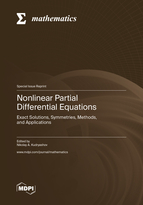Nonlinear Partial Differential Equations: Exact Solutions, Symmetries, Methods, and Applications
A special issue of Mathematics (ISSN 2227-7390). This special issue belongs to the section "E: Applied Mathematics".
Deadline for manuscript submissions: closed (31 August 2022) | Viewed by 53798
Special Issue Editor
Interests: nonlinear mathematical model; differential equation; exact solution; dynamical system; Painlevé equation; Painlevé test; symbolic calculations; transformations; symmetry; Lie groups; dynamic chaos
Special Issues, Collections and Topics in MDPI journals
Special Issue Information
Dear Colleagues,
Nonlinear partial differential equations are encountered in various fields of mathematics, physics, chemistry, and biology, and numerous applications. Exact (closed form) solutions of differential equations play an important role in the proper understanding of qualitative features of many phenomena and processes in various areas of natural and engineering sciences. Exact solutions of nonlinear equations graphically demonstrate and enable the unraveling of the mechanisms of many complex nonlinear phenomena, such as the spatial localization of transfer processes, the multiplicity or absence of steady states under various conditions, the existence of peaking regimes, and the possible nonsmoothness or discontinuity of the sought quantities. It is important to note that exact solutions of the traveling-wave and self-similar solutions often represent the asymptotics of much wider classes of solutions corresponding to different initial and boundary conditions; this makes it possible to draw general conclusions and predict the dynamics of various nonlinear phenomena and processes. Even the special exact solutions that do not have a clear physical meaning can be used as “test problems” to verify the consistency and estimate errors of various numerical, asymptotic, and approximate analytical methods. Exact solutions can serve as a basis for perfecting and testing computer algebra software packages for solving partial differential equations. This Special Issue aims to collect original and significant contributions to both exact solutions and topics related to symmetries, reductions, analytical methods, and different applications of nonlinear PDEs. In addition, this Special Issue may serve as a platform for the exchange of ideas between scientists of different disciplines interested in nonlinear partial differential equations and partial functional differential equations.
Prof. Dr. Nikolai Kudryashov
Guest Editor
Manuscript Submission Information
Manuscripts should be submitted online at www.mdpi.com by registering and logging in to this website. Once you are registered, click here to go to the submission form. Manuscripts can be submitted until the deadline. All submissions that pass pre-check are peer-reviewed. Accepted papers will be published continuously in the journal (as soon as accepted) and will be listed together on the special issue website. Research articles, review articles as well as short communications are invited. For planned papers, a title and short abstract (about 100 words) can be sent to the Editorial Office for announcement on this website.
Submitted manuscripts should not have been published previously, nor be under consideration for publication elsewhere (except conference proceedings papers). All manuscripts are thoroughly refereed through a single-blind peer-review process. A guide for authors and other relevant information for submission of manuscripts is available on the Instructions for Authors page. Mathematics is an international peer-reviewed open access semimonthly journal published by MDPI.
Please visit the Instructions for Authors page before submitting a manuscript. The Article Processing Charge (APC) for publication in this open access journal is 2600 CHF (Swiss Francs). Submitted papers should be well formatted and use good English. Authors may use MDPI's English editing service prior to publication or during author revisions.
Keywords
- nonlinear partial differential equations
- reaction–diffusion equations
- wave type equations
- higher-order nonlinear PDEs
- partial differential equations with delay
- partial functional differential equations
- exact solutions
- traveling-wave solutions
- self-similar solutions
- generalized separable solutions
- functional separable solutions
- classical symmetries
- nonclassical symmetries
- weak symmetries
- symmetry reductions
- differential constraints
- Painlevé properties
- analytical methods for PDEs
- methods of computer algebra
Benefits of Publishing in a Special Issue
- Ease of navigation: Grouping papers by topic helps scholars navigate broad scope journals more efficiently.
- Greater discoverability: Special Issues support the reach and impact of scientific research. Articles in Special Issues are more discoverable and cited more frequently.
- Expansion of research network: Special Issues facilitate connections among authors, fostering scientific collaborations.
- External promotion: Articles in Special Issues are often promoted through the journal's social media, increasing their visibility.
- Reprint: MDPI Books provides the opportunity to republish successful Special Issues in book format, both online and in print.
Further information on MDPI's Special Issue policies can be found here.






